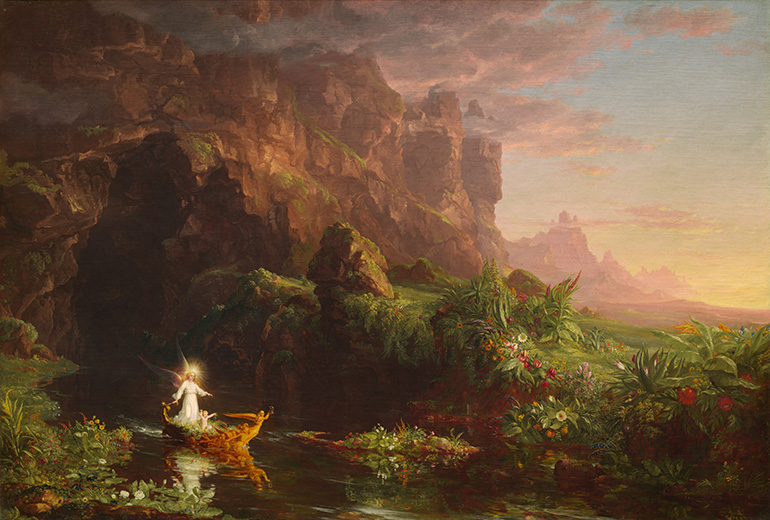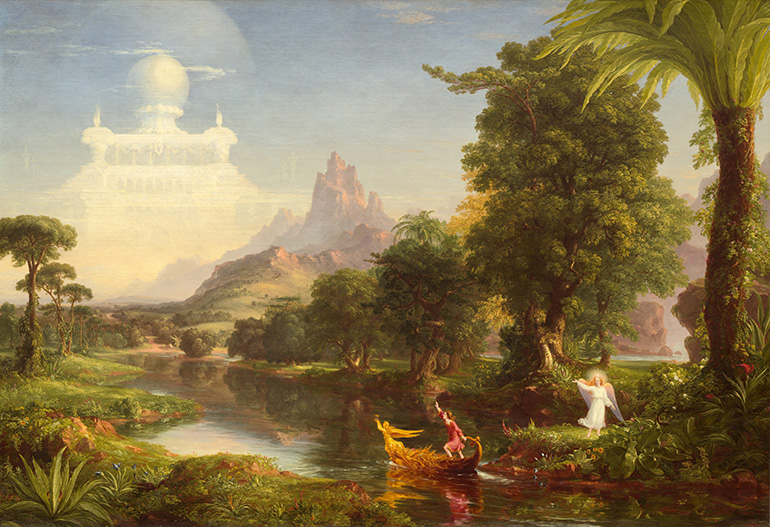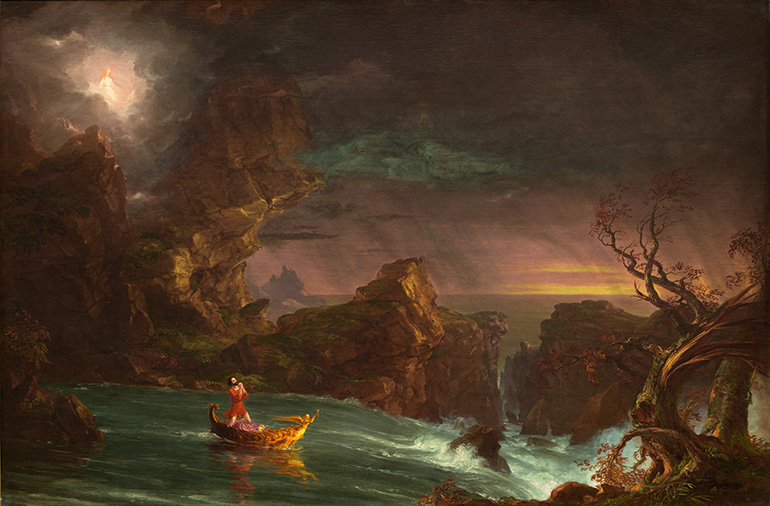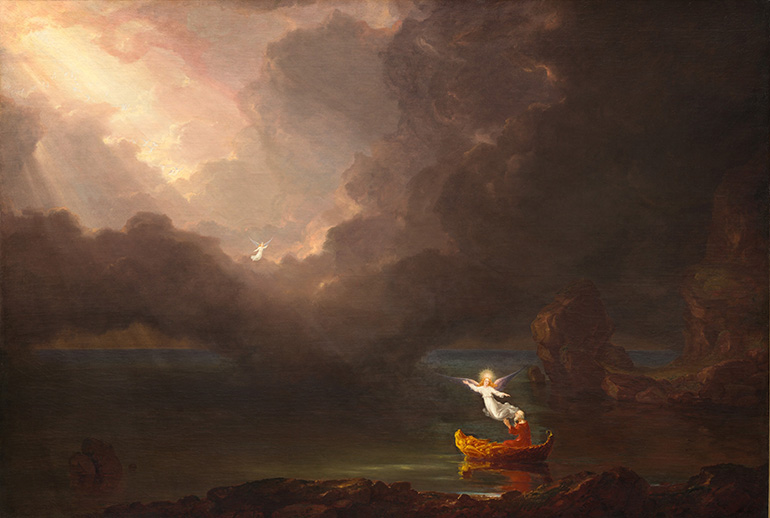
Christmas reflection: 'The Voyage of Life'
Wednesday, December 6, 2023
Emily Chaffins
As Christmas draws near (along with the chances of below-70 temperatures and treetop-falling iguanas in Miami), we often reflect more on God’s presence in our lives. God wants so much to be an ever-present part of our lives that he was born as a baby in a manger to share in our jokes, suffer alongside us, and ultimately die for us. He stays with us in the Eucharist and is actively involved in every detail of our lives, whether we realize it or not.
In his oil-on-canvas series, “The Voyage of Life,” created in 1842, Thomas Cole allegorically depicts the stunning masterpiece that is the journey of human life. When I first saw this series, displayed in the National Gallery of Art in Washington, D.C., I was captivated by the warm, vibrant colors and enchanting stories told in Cole’s four paintings depicting stages of life: Childhood, Youth, Manhood, and Old Age.

Photographer: Courtesy National Gallery of Art
The Voyage of Life: Childhood, 1842. Oil on canvas. Thomas Cole. (Public domain)
In Childhood, a baby floats on a golden boat gliding down a crystal-clear river. The baby’s guardian angel steers the boat, and the vessel is decorated with depictions of angels, who carry the child on their backs down the “River of Life.” One of the decorative angels holds an hourglass in its hands, symbolizing the fact that God guides every moment of our lives. The whole scene is bathed in pastel gold, pink, and blue to symbolize the dawn of this child’s life.

Photographer: Courtesy National Gallery of Art
The Voyage of Life: Youth, 1842. Oil on canvas. Thomas Cole. (Public domain)
The river winds more quickly in the Youth stage as the young man races forward to take life by the reins. Ahead in the sky is a misty palace, towards which he eagerly steers. On the shore, the young man’s guardian angel stands with an open hand extended, encouraging him toward the palace. God has given us free will and allows us to chart our own course through the choices we make.
In 1836, six years before finishing the series, Cole jotted down his plans for Youth in “Allegory of Human Life – a series”: “The child become a youth is seen in the boat — the river has increased and the scene become extensive and grand — the guardian just stepping out of the boat and pointing forward — leaving the youth to his own reason for guide” (Kelly, Franklin, et al. “American Paintings of the Nineteenth Century: Part 1,” Editors Office, National Gallery of Art, 1996).
As Cole states, God gave us intellect and reason so that we can make good choices and live happy lives. To live to our full potential, we have to align our reason with God’s will. God gives us the ability to form our intellect, giving us our guardian angels, parents, family, friends, mentors, and the Catholic Church that is guided by the Holy Spirit.
So, from a Catholic perspective, God never “step[s] out of the boat.” He doesn’t step back and observe us from afar. He’s intimately involved in every part of our lives. God wants to be our close friend and confidant. In Cole’s painting, God’s closeness with us is symbolized by the decorative angels on the boat surrounding the young man.

Photographer: Courtesy National Gallery of Art
The Voyage of Life: Manhood, 1842. Oil on canvas. Thomas Cole. (Public domain)
Sharply contrasting with the bright colors and green landscapes in Childhood and Youth, Cole’s depiction of Manhood is of a wild, storm-wracked river. Surrounded by treacherous rocks and wind-splintered trees, the man kneels on his boat and clutches his hands in agonized prayer. His steering apparatus is broken – a reflection of the consequences of human brokenness that bring us to our knees.
The sky, although filled with ominous teals, dark purples, and grays, is lit up with a brilliant white light from heaven. The light spills into the forbidding rocks that are trying to obstruct the man’s course. In the middle of the light, the angel remains constant, listening to the man’s prayers. Again, Cole states that the “guardian [is] seen at a distance watching” – according to Catholic belief, the angel would be right there in the boat with the man, rather than far away.
The man’s face is turned toward an orange and pink horizon that glows, reflected on the boat’s bow, symbolizing the man’s hope. The man’s gaze is pointed toward hope, just like we firmly fix our gaze on hope during Advent.

Photographer: Courtesy National Gallery of Art
The Voyage of Life: Old Age, 1842. Oil on canvas. Thomas Cole. (Public domain)
In the final scene, Old Age, the white-bearded man has reached the end of his earthly journey. The bow of the boat has cracked off: the angel holding the hourglass is gone, symbolizing that time has ended. The steering apparatus is also gone.
The river’s current is dead and the scene is somber, but a magnificent light shines from heaven as hundreds of angels soar down to meet the old man and guide him home. As Catholics, we believe that we are always in the company of the saints and angels in heaven, who are interceding on our behalf.
The old man’s eyes aren’t fixed, as Cole writes, on the “chaos and darkness spread before... [T]hrough an opening in the clouds a glorious city [is] seen— and seen approaching the old man [is] the guardian who points to the city.”
The man’s guardian angel points to heaven, and the man’s hands are open in surrender. No more is he gripping the controls of his boat as in Youth. He is ready to let God guide him through his final journey to eternity.
Time has ended, but eternity is just beginning.
As we continue through Advent and Christmas, let’s renew our trust in God, assured that he is with us in whatever stage of life we are in right now.


Comments from readers